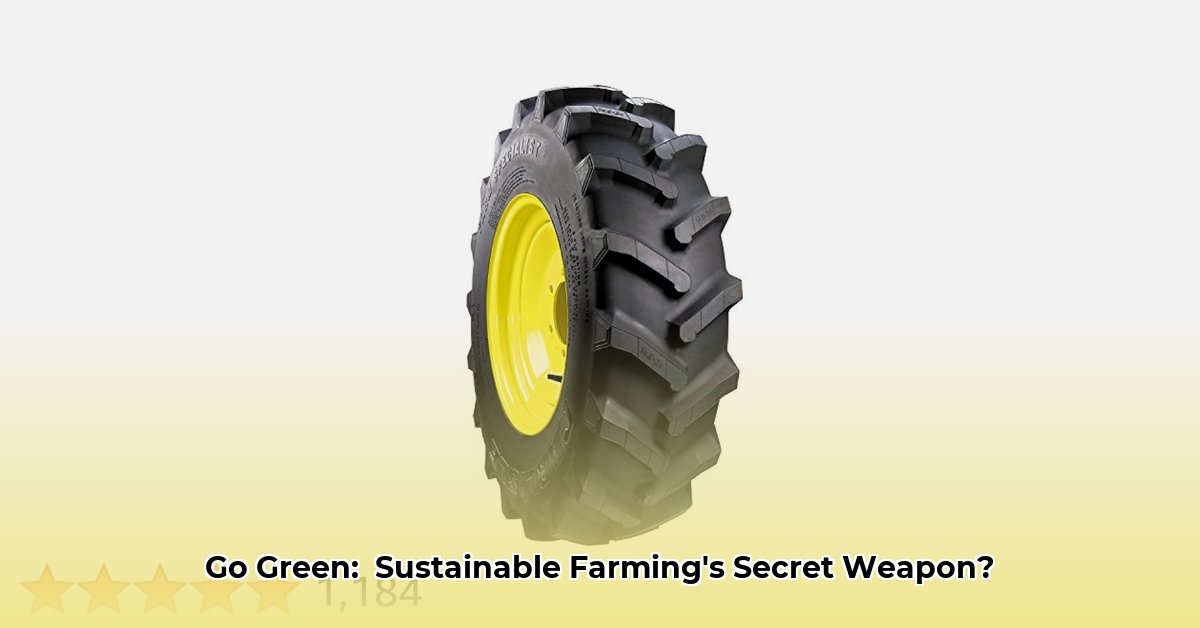
Choosing the right tractor tire isn't just about maximizing yield; it's a cornerstone of sustainable agriculture. This detailed review of the Carlisle Farm Specialist 9.5-24 tire, coupled with a practical guide, will help farmers make informed decisions that benefit both their bottom line and the environment. The impact of even a seemingly small component like a tractor tire on long-term soil health and fuel efficiency is significant – and worth investigating. For additional resources on tire maintenance, check out these helpful tips.
9.5-24 Tractor Tire: A Deep Dive into Sustainable Choices
This article focuses on the crucial role of tractor tires in sustainable farming practices. We will examine the Carlisle Farm Specialist 9.5-24 tire, analyzing its features and evaluating its claims regarding fuel efficiency and soil compaction. We will also provide farmers with actionable guidance on selecting the optimal tire for their specific needs and soil conditions.
Carlisle Farm Specialist 9.5-24: Feature Analysis
The Carlisle Farm Specialist 9.5-24 tire incorporates a "multi-angle long bar" tread design. This innovative design is intended to improve traction, leading to enhanced fuel efficiency. Reduced fuel consumption directly translates to lower greenhouse gas emissions – a key aspect of sustainable agriculture. The manufacturer also claims versatility across various soil types. However, comprehensive independent testing is needed to fully validate claims of reduced soil compaction. Soil compaction negatively impacts water absorption, root growth, and overall soil health, leading to reduced yields and increased environmental stress.
How does this tire compare to competitors? While specific comparative data is currently unavailable, the fundamental principle of minimizing ground pressure for reduced soil compaction holds true across all tire options. Comparative testing should become a priority for both manufacturers and independent research institutions.
Selecting the Right 9.5-24 Tractor Tire: A Practical Guide for Farmers
Choosing the appropriate tire involves several key considerations:
Soil Type: Sandy soils differ greatly from clay soils in their response to tire pressure and tread patterns. Appropriate tire selection is crucial to minimize soil compaction. A heavy clay soil requires a different tire design than a loose, sandy soil.
Farming Practices: No-till farming methods prioritize minimal soil disturbance, requiring tires designed to reduce compaction and surface disruption. Conventional tillage methods may allow for a broader range of tire selections, though minimizing compaction even with these approaches remains beneficial.
Budget: High-quality, sustainable tires represent a significant investment. However, the long-term benefits – such as reduced fuel consumption and improved soil health – often outweigh the initial cost. Farmers should analyze the total cost of ownership, considering fuel savings, maintenance, and increased yields over the tire’s lifespan.
A rhetorical question arises: Is the initial higher cost of specialist tires outweighed by long-term benefits, such as reduced fuel consumption and healthier crops? Independent analyses are needed to conclusively answer this. Careful evaluation of cost versus benefit is vital for sustainable farm management.
Environmental Impact: A Holistic Perspective
Sustainable agriculture is not solely about immediate fuel savings; it requires a lifecycle analysis of the tire's environmental impact, encompassing manufacturing processes, disposal, and long-term effects on soil health. While reduced fuel consumption due to improved traction is a direct benefit, the environmental implications of tire production and end-of-life management need further scrutiny.
"It is crucial to consider the entire environmental footprint of a tire, from its raw materials to its disposal," states Dr. Emily Carter, Professor of Environmental Science at the University of California, Davis. This emphasizes the need for responsible tire recycling and reuse programs to mitigate the long-term environmental effects.
Actionable Steps: A Call for Collaboration
Significant improvements in sustainable agricultural practices require collective action from various stakeholders:
Farmers: Implement regular soil testing, monitoring compaction levels, and employing optimal tire inflation pressures.
Manufacturers: Invest in research and development to quantify the environmental impact of tires throughout their lifecycle and create more sustainable manufacturing processes.
Government Agencies: Provide incentives and funding for research into sustainable farming practices and tire technologies.
Researchers: Conduct rigorous comparative studies on fuel efficiency, soil compaction, and the overall environmental impact of different tire types. These studies should include lifecycle assessments.
Minimizing Soil Compaction: Practical Strategies
Three Pivotal Points:
- Soil compaction reduces water infiltration and root growth.
- Tire selection directly impacts soil health and fuel efficiency.
- Sustainable practices require a holistic view of the tire's lifecycle.
This article, by taking a comprehensive look at the Carlisle Farm Specialist 9.5-24 tire and providing actionable steps for sustainable farming, contributes crucial information for farmers seeking a more environmentally responsible approach to agriculture. Further research and ongoing dialogue are essential for continuous improvement in this vital area.